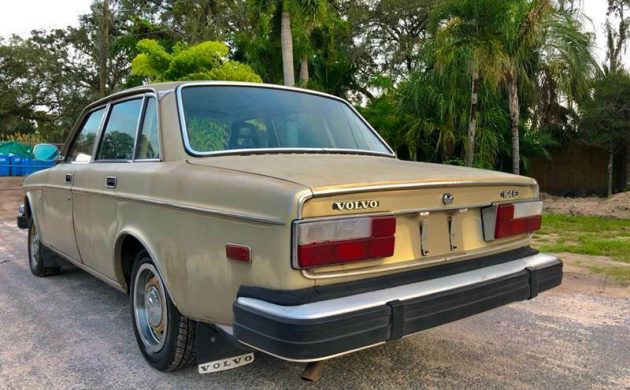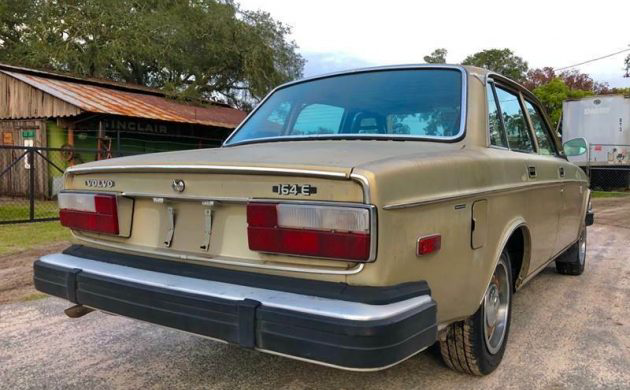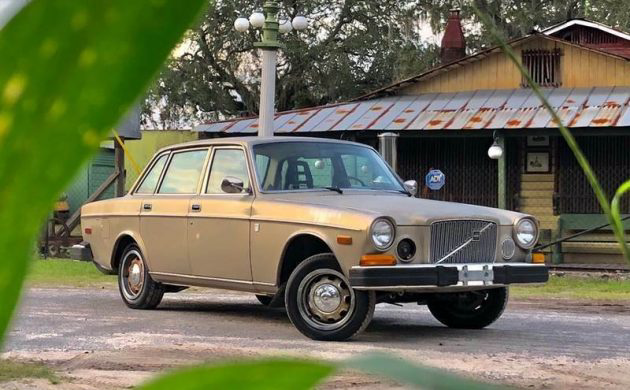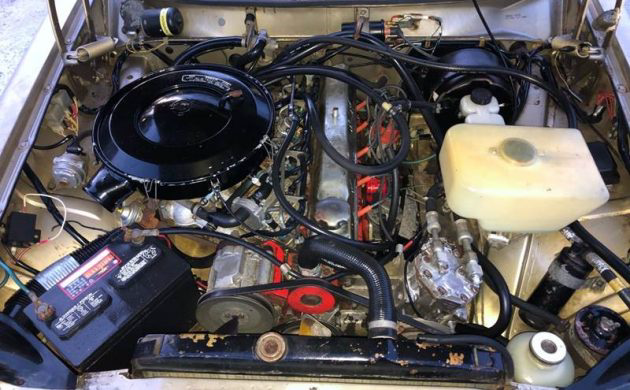Storage Rescue: 1975 Volvo 164E
It is funny how cars from different countries almost always uniquely reflect the culture of that country. We could go into the different personalities of Italian cars vs. British cars, or Japanese vehicles in comparison to American ones. However, to keep the conversation simple, let’s stick to Swedish cars. Volvos in particular, like this 1975 Volvo 164E for sale on eBay in Tampa, Florida. This boxy yet cool Volvo four door fits the Swedish stereotype: conservative and efficient. This storage rescue Swede has just over 100,000 miles on the odometer, runs and drives, and is a stick shift car. With the very spirited bidding currently at $3,450, is this a sign that these neat sedans are finally being recognized for their many positive, and very Swedish, attributes?
The idea of Volvo collectability is not a new one. America’s love affair with Volvos began when the first PV444 was brought to America in 1955. Easy to like because of their charming retro before retro was cool good looks, it was soon obvious to owners that the company made very durable cars that were fun to drive. Later models, like the refined PV544, 122S, and P1800, continued to impress customers and built up a loyal following. They even developed a racing heritage for the company. The arrival of the boxy 140 in 1966 added a new description to the brand: safe.
With a number of advanced safety features, these boxy Volvos became even more popular. As this body style aged, it was evolved and refined from the 140 to the 164 Series, and then evolved again into the 240 Series. The basic body style lived on until 1993. Collector interest in these cars has slowly risen over the years, especially as the prices of previous Volvos have climbed. Still, these cars have a following due to their many positive attributes. It also doesn’t hurt that they can be built into very fast touring sedans.
This 164E was rescued from storage, cleaned up, and is currently a running and driving vehicle. There are a number of issues for the next owner to deal with. The sunroof has been caulked shut, there are various rips and tears in the upholstery, and the air conditioning doesn’t work. Rust has gotten a bit aggressive in a few areas, but there are no obvious signs of rust through. Pictures of the floorpan in the ad reveal a very solid car. The best part is that the car is equipped with a four speed manual transmission with overdrive.
The car is powered by one of Volvo’s silky smooth inline six cylinder engines. As you can see from the photo above, the engine bay looks very tidy and clean after an obvious pressure washing treatment. These 164s were fuel injected, which made these engines much more fuel efficient and, thus, cleaner burning. Like the four cylinder engines that they were derived from, Volvo inline sixes are well known for longevity and durability.
A number of items need to be fixed on this car. Most of them are minor, except for the air conditioning system. It also could use a paint job. Or, it could be used as-is, with an improvement or repair here and there. The fact that it is running and ready for the road is a big plus. The new owner can enjoy the car and its many attributes while bringing it back to snuff. You can see how the attributes of durability, longevity, safety, and quirky good looks in these cars can grow on a person.
What would you do with this Volvo?
Auctions Ending Soon
 2002 Subaru Impreza WRXBid Now1 days$333
2002 Subaru Impreza WRXBid Now1 days$333
 1975 Chevrolet Corvette ConvertibleBid Now1 days$4,000
1975 Chevrolet Corvette ConvertibleBid Now1 days$4,000
 1964 Ford F-100 Camper CustomBid Now1 days$2,000
1964 Ford F-100 Camper CustomBid Now1 days$2,000
 2006 Jeep Wrangler SportBid Now3 days$11,000
2006 Jeep Wrangler SportBid Now3 days$11,000
 1974 Datsun 260ZBid Now5 days$750
1974 Datsun 260ZBid Now5 days$750






Comments
Lovely looking car. I’ve always loved Volvos of the 70s and 80s.
Greetings All,
Had one. Liked much about it. I don’t believe electric windows were available but had every other option. Sunroof, AC, leather uppers and heated seats.
One problem, they couldn’t make a 12vdc motor to save their lives. Both wiper and blower motor for heater entailed an amazing amount of things removed and then repaired. Heater ducts brittlized
Add to this the 164E had a lot of things, like those motors that were unique to that model.
I evolved into this after a series of fintail Mercedes.
All in all a fun car, I loved the sunroof.
All it needs for me would be ’72 bumpers, grill, and front doors. And also, mill the head and tweak the injection just a tad.
Our family had two of these. One ended up being the equipment hauler for a rock band which made sense as the trunk on these is huge as is the back seat. Manual shift cars are rare and a great find with the O/D.
Just so funky, they’re cool ! Under the hood looks very tidy.
Aside from the looks, which I liked very much and still do, what impressed me most about R&T’s road test of the then-new one was the comparison to the other road test, of the also-new MGC. Both cars had a 3-liter six under the hood, but the significantly heavier Volvo four-door was both rather faster and very much quicker than the MG sports car. I have that issue somewhere, if anyone needs chapter and verse, but I remember being pretty tickled that this pretty sedan would smack that poor Federally crippled roadster right down. Of course I was more than somewhat PO’d about what the Feds were doing to our cars, but maybe more at the lame penny-pinching way the car makers were responding.
Greetings All,
Will Owen, if I had to guess, and I don’t because I’m familiar with another British marque, Volvo was prepared for the US Federal Emissions, MG, or British Leyland in general was not.
Jaguar dropped SU because they could not pass and SU had NOTHING in the pipeline. Luckily the Zenith Strangleburg could manage to flow gas and only lose 25 horses for Jaguar. The strombergs did the same for MG but they didn’t have the extra oooomph to lose.
The Bosch fuel injection was pretty good, and it was forward thinking for the times.
It was surprising to see hiw poorly prepared any of the big 3 were when the new regs hit.
Just look at Corvette. Well under 200 HP in the late 70’s.
Ross, that pretty much pulls the pieces together: Our manufacturers responded to the strangulation by going big-block, and the Brits did much the same … as though adding one liter of massive iron lump would put the zing back in the B, and never mind the jacking job on the front suspension.
Yes, Bosch not only had a coherent answer in their electronic FI, they did a good job of improving it, and have not stopped doing that. I’ve had three L-Jetronic (I think) Alfas, and an Italian guy who can make any of them not only pass smog (as long as the catalytic convertor was up to snuff) but get better numbers than my much newer Subaru Forester. And I know that although the Alfa 2-liter dropped from 130 to about 85 hp while they still had the SPICA injection, as soon as they went Bosch they got most of their old poo back … to the point where I’d actually be interested in a ’90s Spider.